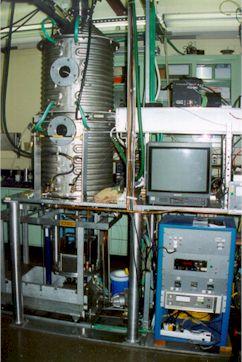Radiative Gasification Apparatus

This apparatus, developed at EL, determines gasification rate (mass loss rate) of a horizontally oriented specimen exposed in a nitrogen environment to a controlled radiant heat flux from a cone-shaped heater. These non-flaming conditions allow the condensed-phase gasification processes to be de-coupled from complicating gas-phase processes; permit a better estimate of the actual incident heat flux that is producing the fuel gas; and provide a much better view of surface phenomena (e.g., bubbling, charring) during degradation. The cylindrical chamber is 0.61 m in diameter and 1.70 m in height. Two windows provide optical access. The chamber's interior walls are blackened and water cooled to 25 EC to minimize indirect heating of the specimen. The cone-heater temperature is usually fixed at 809 EC to maintain a constant emission spectrum. Changing the distance between the sample and heater can vary incident heat flux to the sample between approximately 25 kW/m2 and 70 kW/m2. A water-cooled shutter is extended to protect the sample from the incident heat flux prior to testing: it also can be used to quickly halt the exposure at any time to "freeze" the remaining sample for subsequent chemical/physical analysis. Flux levels vary approximately 8-10% across a 0.1 m diameter specimen. Product and ambient gases are removed via an exhaust duct by a constant nitrogen flow of 7.7 l/s at 25 EC. Degradation products can be collected above the specimen's surface and condensed in a cold trap for further chemical analysis. Load cell data are taken every 0.5 s with an uncertainty less than 1% over a 100 g range. Specimens instrumented with thermocouples also can be accommodated.
Specifications/Capabilities
The gasification apparatus usually is used to study the effects of fire-retardant additives on condensed-phase reactions in synthetic polymers; the data generated provide insight into the chemical and/or physical mechanisms responsible for improved flammability. In addition, the heat of gasification of the specimen, a necessary property for mathematical modeling of the gasification process, can be determined from the data.
Usage Information
Access Information
Industry, university, and government representatives are encouraged to use this apparatus on a collaborative or independent cost-reimbursable basis, with certain restrictions.

